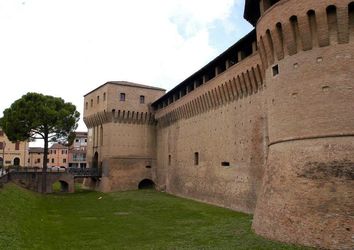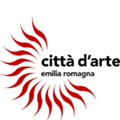Forlimpopoli
 The town was built along the Via Emilia (SS. 9) between Forlì and Cesena on the place where the road meets the Bidente Valley (Ronco). The town is of Roman foundation and grew around the fortress which was destroyed and later rebuilt by the Cardinal Albornoz, Papal legate, in the 16th century. Forlimpopoli was ruled by different lords in the 15th and 16th century until it became a fief of the Zampeschi family by papal concession. Forlimpopoli also is the birthplace of Pellegrino Artusi reputed to be the father of Italian gastronomy .
The town was built along the Via Emilia (SS. 9) between Forlì and Cesena on the place where the road meets the Bidente Valley (Ronco). The town is of Roman foundation and grew around the fortress which was destroyed and later rebuilt by the Cardinal Albornoz, Papal legate, in the 16th century. Forlimpopoli was ruled by different lords in the 15th and 16th century until it became a fief of the Zampeschi family by papal concession. Forlimpopoli also is the birthplace of Pellegrino Artusi reputed to be the father of Italian gastronomy .
Forlimpopoli lies in the province of Forlì-Cesena and extends across the flat Romagna plain, at the foot of the Apennine hills at about 25 kilometres from the Adriatic sea.
It is a town full of history and was founded by the Roman consul Popilius Lena in 132 b.C. under the name Forum Popili. It entered the Exarchate of Ravenna and had its first bishop, the Athenian Rufillus, in the 5th century, on whose tomb was built, just outside the town, a Benedictine abbey.
In the 7th century the church was devastated by the army of the Lombard king Grimoaldo and in the following century it passed under the dominion of the Church. In the 18th century the town came under the rule of the Ordelaffi family from Forlì, but it was reconquered by the Church with the Cardinal Albornoz who commanded in 1361 its destruction and later ordered to rebuild on the site of the cathedral the new fortress with four circular towers and rampart walk. The underground rooms host the Civic Archaeological Museum with beautiful mosaics, bronze and glass artifacts and fragments of wine amphorae made during the Imperial Roman age. In the 15th and 16th century Forlimpopoli was ruled by different lords such as Caterina Sforza and Cesare Borgia.
In 1535 the town was first granted by the Pope as perpetual fief to Antonello Zampeschi, then to his heirs, the Savelli princes, and finally to the Cardinal Capponi. After the Napoleonic occupation, Forlimpopoli came back to the Papal State. During the Risorgimento (struggle for Italian unification) the town took actively part in the freedom revolts, while in 1851 it came in the limelight for the raids of the bandit Stefano Pelloni, known as the “Passatore”, who plundered the town with his band. This event shook Pellegrino Artusi, who was at that time still a child, reputed to be the father of Italian cuisine for the book “Science in the Kitchen and the Art of Eating Well”. Every year the town honours its most famous citizen with a feast called the “Artusi Week”, a cultural-gastronomic fair at international level. Not to miss is the Albornoz Fortress, the Archaeological Museum, the Basilica of San Rufillo and in the surroundings the Fornò Sanctuary and the natural oasis of Selbagnone.
Altitude: above sea level
Inhabitants: 11358 inhabitants
Surface: 24 kmq
How to get there
Forlimpopoli can be reached either by car driving along the Via Emilia or by train along the Bologna-Ancona rail line (Forlimpopoli-Bertinoro station). From the A14 motorway, leave it at Forlì exit (from the north) or Cesena exit (from the south). On the E45, the freeway connecting Ravenna to Rome, the best exit is Cesena ovest.
From Forlì railway station take the 92 busline at the nearby Forlì Puntobus (Bus station) in 1, Via Volta (tel. +39.0543.27821).
The municipality of Forlimpopoli is bounded on the north and on the west by the municipality of Forlì, and on the south and on the east by the municipality of Bertinoro. It also includes the hamlets of Selbagnone, Sant’Andrea, San Pietro ai Prati and a part of the hamlet of San Leonardo.
To have tourist informations
Address: Via Andrea Costa, 23 - 47034 - Forlimpopoli
Telephone number: +39.0543.749250
Fax: +39.0543.749247
mail: turismo@comune.forlimpopoli.fc.it
Sito WEB: http://www.forlimpopolicittartusiana.it/
Other News
There is also the opportunity to visit the farming companies and holiday farms associated with the Wine and Food Route of the hills around Forlì-Cesena.
Torna indietro
Comune di Forlì - Piazza Saffi, 8 47121 Forlì
PEC: comune.forli@pec.comune.forli.fc.it - P.Iva: 00606620409
A cura della Redazione di Turismo Forlivese, Piazza Saffi 8, 47121 Forlì - iat@comune.forli.fc.it - Tel. 0543 712362














